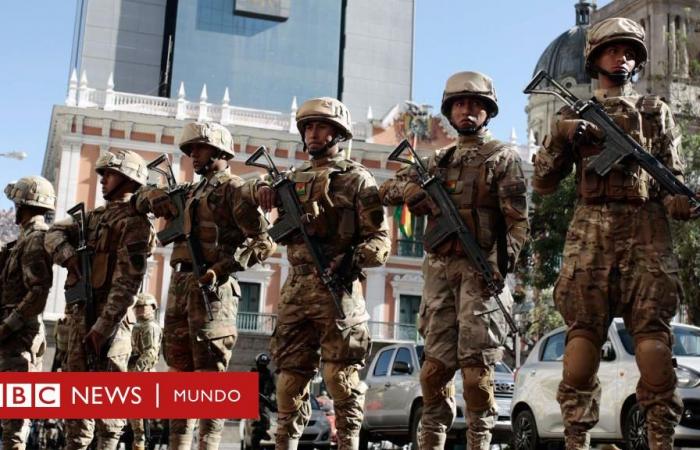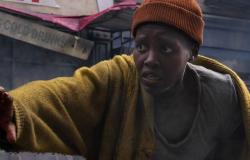
Image source, Getty Images
- Author, Fernanda Paul
- Role, BBC News World
-
1 hour
The attempted coup d’état denounced this Wednesday by President Luis Arce reflects the complex situation that Bolivia is going through.
The president’s complaint occurred after soldiers and military vehicles took control of Plaza Murillo in the Bolivian administrative capital, La Paz, and accessed the Palacio Quemado, the former headquarters of the government.
The military actions were led by General Juan José Zúñigawho had recently been dismissed as head of the Army after making statements against former President Evo Morales.
Zúñiga based his attack on the press on the “situation of the country” and added that the Armed Forces intended to “restructure democracy.”
Although the military uprising was controlled hours later – and Zúñiga was arrested – Bolivians are living hours of uncertainty.
The episode, repudiated by all political sectors, is an example of the growing tension in which Bolivia has been immersed in recent months.
What factors have fueled this tension? Here we tell you.
1. Political fight between Luis Arce and Evo Morales
The attempted coup denounced by Arce is the latest episode in the turbulent political history of Bolivia.
In its 200 years of history, the Andean country has faced different military uprisings and uprisings that have made Bolivian leaders tremble.
The causes have been diverse, as have the political scenarios in which they have occurred.
This time, General Zúñiga’s attack was preceded by a growing power fight between former president Evo Morales and his successor, Luis Arce.
Image source, Getty Images
This has caused a division of the Movement to Socialism (MAS)the ruling party.
The rift was revealed in September 2023, when Morales announced his presidential candidacy for the 2025 elections, openly challenging Arce, who is expected to seek re-election.
The former president accused the government of trying to stop his candidacy. And he has threatened that there will be a “seizure” in Bolivia if they disqualify him.
Evo Morales led the country for almost 14 years until he had to leave in 2019 after elections that were marked by accusations of fraud.
The leader denounced a coup d’état with the support of the United States and went into exile.
After an 11-month interim government, Luis Arce achieved a decisive victory in the October 2020 elections, thus ushering in the return of the former president.
But the enthusiasm only guaranteed a few months of calm, as soon after the division began to grow between the two MAS leaders. To the point that this year the party celebrated its 29th anniversary in separate events, with the “evistas” in Santa Cruz and the “arcistas” in La Paz.
The political struggle has moved to Congresswhere Arce lost the majority due to the MAS split.
The doctor in Political Science Fernando Mayorga He explained to BBC Mundo in September 2023 that the fracture of the ruling bloc caused parliamentarians sympathetic to Morales to have advanced in agreements with the opposition to block decisions of the Executive or censure ministers, which has been bothering Arce for months.
All of this has led to the government accusing Morales of provoking a “structural crisis scenario in the country” in order to “shorten” Arce’s mandate.
“Evo Morales is willing to block our economy and convulse our country to impose his candidacy by hook or by crook, as he himself has said,” declared the Minister of the Presidency, Maria Nela Pradain a press conference held on Sunday, June 23.
Morales, for his part, wrote on his
Image source, Getty Images
Arce, for his part, has said in various public statements that he is the subject of a “soft blow” which aims to “shorten mandates” and behind which would be the followers of Morales, to which the former president has said that “the only ones who talk about shortening the presidential mandate They are the members of the government themselves.”
After the military uprising that occurred this Wednesday in La Paz, General Zúñiga – who has been described as close to Luis Arce and the mining and union sectors – accused the president of staging a “self-coup” to “raise his popularity.”
2. Deterioration of the Bolivian “economic miracle”
All of this political struggle occurs at a very complex economic time for Bolivia.
Road blockades and demonstrations have gained strength in recent months due to the deterioration of its economy, which, paradoxically, has stood out within Latin America in the last decade due to its rapid growth, stability and ability to contain inflation.
Some even called it “the Bolivian economic miracle.”
But this model showed its cracks in March 2023 when a serious dollar shortage and long lines of citizens began to appear in the streets trying to get the currency.
“The availability of dollars is becoming less and less. Before, I could get what I wanted, but today they only allow me 100 dollars per day,” Marcelo Pérez, a photographer and journalist who lives in La Paz, tells BBC Mundo.
Image source, Getty Images
Image source, Getty Images
The above has given way to a parallel dollar market, explains Bolivian economist and international financial consultant Jaime Dunn.
“Personally, I have estimated that we have 13 types of parallel changes, between formal and informal,” he tells BBC Mundo.
Although the Arce government has insisted that the economy remains stable – and has blamed what happened on “a speculative outbreak”– many experts warn that the problem is much deeper.
And that is explained, in part, by the drop in the level of natural gas production which gave considerable income to the country after Evo Morales decreed the nationalization of hydrocarbons in 2006.
“Since 2014, the effect of that bonanza began to be reversed and this caused the level of dollars arriving in the country to drop,” says Dunn.
In parallel, the number of international reserves.
According to reports from the Central Bank, these went from US$15,122 million in 2014 to US$1,796 million in April 2024 (date the last report was published).
With these resources, some of the social programs of the governments of Evo Morales first and Luis Arce later have been maintained, such as the fuel purchase subsidy, that Bolivia has to import and pay in dollars in international markets.
“This has led the country to a crisis because, despite the fact that income fell, very high spending remained. And since 2014, natural gas income began to be replaced by internal and external debt,” explains Jaime Dunn.
The shortage of dollars has especially had an impact on sectors that import or export goods.
Image source, Getty Images
“Bolivia is almost 80% an importer of inputs and capital goods, which is why it has been greatly affected by the shortage of dollars,” he told BBC Mundo. Claudia Pachecopresident of the College of Economists of Santa Cruz.
According to Marcelo Pérez, this can already be felt in the streets, with the increase in the value of some basic products such as rice or tomatoes.
“In the supermarket, some products have increased in price and others have directly disappeared because they can no longer import them as frequently as they did before,” he says.
In recent days, however, the vice minister of defense of user and consumer rights, Jorge Silvastated that there had been managed to stabilize the price of these products.
The shortage of dollars has also directly affected the fuel import.
Bolivia imposed a subsidy on the purchase of fuel more than 15 years ago, which has meant a heavy expenditure on its public accounts.
Now, experts warn, he does not have dollars to buy it. This is problematic if one considers that, according to President Arce himself, Bolivia imports 56% of the gasoline and 86% of the diesel it consumes.
“Bolivia has gone from being a net energy exporter country to being an importer. Just 10 years ago it had been a kind of energy center for South America,” says Jaime Dunn.
The Bolivian president has recognized that the diesel situation is “pathetic.”
According to him, it is due to a “lack of a clear hydrocarbon policy in the country” in recent years.
Now, however, the president has said that they are “doing the right thing” with the approval of projects that are supposed to help guarantee gas, diesel and gasoline reserves.
3. Discontent among Bolivians
The above has generated discontent in the population.
Merchants and transporters have held demonstrations and road blockades in different cities across the country.
While a crowd of street vendors have marched to La Paz denouncing the shortage of dollars and fuel.
“In 2023 we had almost 200 days of blockades, which harmed imports and exports,” says Claudia Pacheco.
Image source, Getty Images
Image source, Getty Images
Long lines of people trying to get fuel have formed at gas stations. Given this, President Arce ordered the militarization of the fuel supply system.
“There are days when diesel is sold, but others when not. Sometimes you have to sleep at gas stations to get it,” one driver told the news agency. Reuters.
The situation has led the government to introduce measures to combat these problems.
In February, the Minister of Economy, Marcelo Montenegromet with business groups and announced a series of economic reforms such as the relaxation of export restrictions and the creation of a diesel auction for large producers.
So far, however, the measures do not seem to be enough.
The tension generated by these episodes It has also hit the popularity of Arce, who has dropped in approval, according to polls.
If he chooses to run in the 2025 election, this may be a problem.
His great challenge, agree the analysts consulted by BBC Mundo, is to solve the economic problems, which is still paradoxical for whom experts describe as the “father of the economic model” current in the country.
Beam click hereGo to read more stories from BBC News Mundo.
And remember that you can receive notifications in our app. Download the latest version and activate them.





